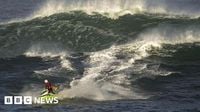As Hurricane Erin barreled up the Atlantic Coast in August 2025, it left a trail of dangerous surf, rip current rescues, and tense moments from North Carolina’s Outer Banks to the rocky beaches of New Hampshire, and even across the Atlantic to the shores of Wales. While the storm itself mostly skirted the U.S. coastline, its far-reaching effects were felt by beach communities and emergency responders alike, who spent days bracing for the worst and scrambling to keep visitors safe.
According to WTVD, coastal flooding began on Tuesday, August 19, along the Outer Banks of North Carolina, with conditions expected to worsen as Erin tracked northeast. The storm was forecast to come closest to the coast late Wednesday night into Thursday morning, and even in fair weather, beaches were to remain hazardous through Thursday night, with waves cresting between 10 and 20 feet. The timing couldn’t have been worse: evacuations on Hatteras Island and Ocracoke occurred during the height of the tourist season, as families and vacationers flocked to the thin, low-lying barrier islands that jut into the Atlantic. By Monday, August 18, there had already been 85 rip current rescues along the North Carolina coast—a sobering reminder of the ocean’s power and unpredictability.
Down in Southeastern North Carolina, WECT reported that Hurricane Erin passed the Carolinas primarily on Thursday, August 21. In the days surrounding its closest approach, communities like Wrightsville Beach issued no-swimming advisories following several rip current rescues. High tides covered much of the sand, leading to minor erosion, though, as Kure Beach Mayor Allen Oliver put it, “I think we dodged a bullet with this storm. We didn’t get hit hard as some other areas did. We’re very fortunate. But it just shows you how strong these storms can be even when they’re off the shore.”
Oliver described how high tides on Wednesday and Thursday reached up to the dune line, but the dunes themselves held strong, suffering only minor erosion. Kure Beach didn’t issue a no-swimming advisory despite a few early-week rescues, relying on lifeguard warnings and the good sense of beachgoers. “I think our people did a pretty good job of staying out,” Oliver noted, acknowledging that late August is a tricky time for staffing as many lifeguards return to college. “So you really rely on people to just listen to what they’re saying.”
Elsewhere, Oak Island’s Communications Manager Mike Emory reported that the beach area fared well, with little erosion and not too many rescues. By Friday, August 22, beach flags were downgraded from red to yellow, signaling a gradual return to safer conditions. Wrightsville Beach Ocean Rescue Director Sam Proffitt confirmed that the dangerous surf was beginning to lighten up and that rip current rescues had declined in recent days. Still, officials across the region urged caution for anyone considering a dip over the weekend.
Further north, the effects of Erin were just as pronounced, if not more so, in places less accustomed to such surf. WMUR detailed how, on Friday, August 22, lifeguards and firefighters in Rye, New Hampshire, rescued several swimmers as the post-tropical remnants of Erin swept past offshore. The storm, downgraded from hurricane status late Friday, unleashed strong waves and an unusual number of rip currents on the state’s beaches throughout the day. "It’s pretty dangerous out here today," said lifeguard Jena Jekums, who assisted in a rescue. "It’s the biggest surf we’ve had probably all year. There’s some rip currents."
Officials in Rye reported that one swimmer needed help returning to shore, while two other rescues involved boogie boarders caught by the currents. Thankfully, no injuries were reported. Jekums explained the challenge: "It’s really easy for people to get stuck in between sets, and they just can’t get in." Despite low lifeguard staffing, help came from the fire department and neighboring beach guards, with jet skis deployed for rescues. By early evening, surfers noted that the waters had calmed somewhat, but authorities warned that high waves and rip currents could persist into the weekend.
Across the Atlantic, the story was much the same. The BBC reported that in Pembrokeshire, Wales, RNLI lifeguards conducted 46 rescues between August 9 and August 15 due to rip currents. The warning to beachgoers was clear: unusually large waves and dangerous sea conditions were expected over the bank holiday weekend, especially as the remnants of Hurricane Erin were set to affect Wales from late Monday, August 25. Surf conditions on Monday and Tuesday could see waves reaching up to 3 meters (nearly 10 feet), particularly in south and west Wales, with a heightened risk of rip currents.
Chris Cousens, RNLI water safety lead, explained the unusual circumstances: "The forecast at the moment for Monday and Tuesday is quite unusual for this time of year as the swell which results in surf is a lot bigger than usual." He warned that the conditions would be hazardous not just for swimmers but also for boaters, kayakers, and stand-up paddleboarders. "If you’re a swimmer there’s increased risk of rip currents and waves, if you’re walking along the coast, particularly as it’s coupled with high tides, there could be water over spilling into areas that wouldn’t normally."
The RNLI also reminded the public of the dangers posed by rip currents—fast-moving channels of water that can sweep even strong swimmers out to sea. The advice is simple: don’t fight the current, swim parallel to the beach, and if that’s not possible, float to live until help arrives. James Instance, HM Coastguard divisional commander, added, "There is the likelihood of strong waves and currents which could lead to people being swept out, particularly children or vulnerable people. Please stay aware of the state of the sea and the tide, and follow our simple guidance to ensure you have a fun day and come home safe."
The impact of Hurricane Erin, even as it stayed largely offshore, was a stark reminder of the ocean’s might and the importance of heeding warnings from lifeguards and officials. While the beaches from North Carolina to New Hampshire and all the way to Wales saw their share of rescues and close calls, the quick work of emergency responders and the cooperation of the public helped prevent tragedy. With climate patterns shifting and storms becoming less predictable, communities up and down the coasts are learning to stay vigilant—and to never underestimate the sea.





